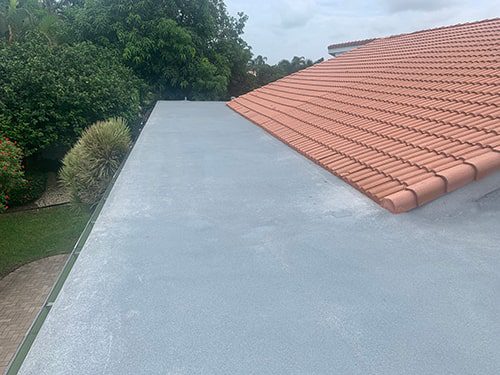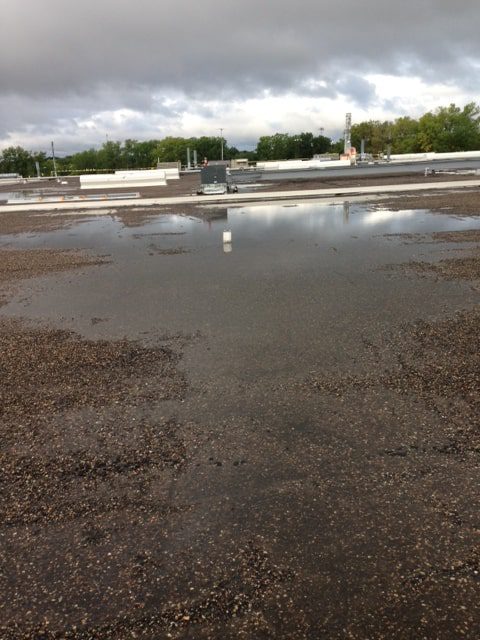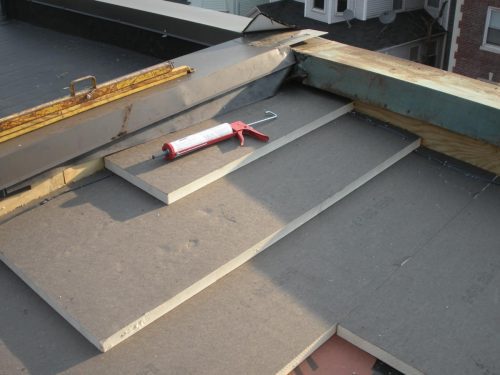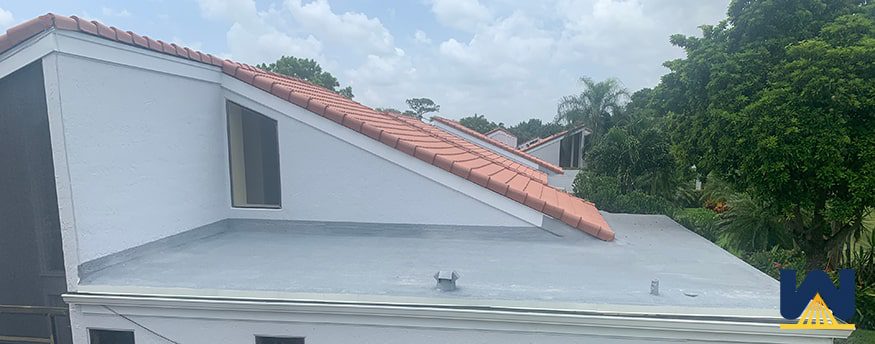Summary: If there’s standing or ponding water on a commercial roof, your roof will not last as long if that water was removed. To remove standing water, you need to install a roof system that can customize the slope. A tapered system (where the slope is created with insulation) is expensive. A more cost-effective solution is to install a spray foam roofing system.
So, you got on your roof today and noticed there’s water that’s “sitting” there.
It’s been 3 days since it rained, and you wonder why this water is still on the roof?
In this article, we’ll explain:
- Why roof slope is important
- How ponding water reduces the life of your roof
- How spray foam can easily increase the slope of a roof
- Why a tapered roof system is expensive
The goal is for any building owner or property manager to understand that ponding water is not good, why, and what possible repair options they have.
West Roofing Systems has been a spray foam roofing company since 1979. In that time, we’ve helped hundreds of roofs with ponding water and sloping issues. The most cost-effective solution is to install spray polyurethane foam.
Let’s get started with a case study!
A slope-raising story – Peppertree II Condos

Before we get into why slope is important, we wanted to point out a case study where installing a spray foam roofing system to solve a sloping issue was more cost-effective than a tapered system.
The case study is called Peppertree Condos II.
Why is slope important?
The slope is important because this is what directs water towards the drains or gutters on a commercial roof. If there isn’t enough slope or there’s an area on the roof that is lower, water will sit there and not move towards a drain.
Any water that doesn’t move towards a drain or evaporate in 48 hours is what’s known as “ponding water”.

Ponding water can reduce the lifetime of your existing roof for the following reasons:
Ponding water accumulates dirt
When ponding water accumulates dirt, it’s creating a darker color on your roof. If you have a light-colored roof that’s designed to reflect UV rays, your roof will be losing reflectivity.
Ponding water accumulates leaves
Leaves naturally blow off a roof that’s clean and dry. But when there’s ponding water, the water acts like a net that captures these leaves. Leaves increase the area of the ponding water, which can further interfere with how water moves on your roof.
NOTE: It’s a rumor that UV rays can be magnified through ponding water to accelerate the degradation of your roof. There’s no evidence that we’ve seen or that any accredited association has published about this, but it’s something interesting to think about.
Sagging roof and deck deterioration
Standing water adds weight to your roof. Over time, this can cause the roof to sag, which causes an opportunity to collect more standing water.
If the roof cannot hold the added weight of the water, the roof could collapse.
Vegetation
With excess moisture on the roof, weeds, algae, and other forms of vegetation can grow on your roof.
The vegetation could lead to debris that could clog your drains, which only increases the standing water on the roof.
Ice Damage
This is important for roofs in colder areas. Ice formations from ponding water can cause damage to the membrane from freeze-thaw cycles.
Now that we understand why standing/ponding water is no good for a roof system, how can we easily add slope?
How to easily increase the slope of a commercial roof?
Most haven’t heard of it, but a spray polyurethane foam roof can easily add slope to a commercial roof.
How?
Spray foam is fluid-applied, meaning the slope can be customized by the amount of spray foam that’s installed.
Here’s a video of spray foam being installed on a roof:
A spray foam roofing contractor will gather information about the roof, such as:
- Where is ponding water present?
- What path does water take to reach a drain?
- What is the current slope?
- What slope is needed to make sure there’s no standing water
Once all the data is collected, a contractor will detail the best way to increase the slope and make sure no standing water occurs on the roof.
How else can you increase the slope of a commercial roof?
The slope can be increased by installing a tapered roof system.
A tapered system is where the slope is created through the insulation.

This requires the membrane and the existing insulation to be removed and replaced.
Then a contractor will install the insulation at a slight angle that will direct water towards drains. Then the new membrane is installed over the new insulation.
The problem with this is that it’s expensive.
Tear-off and new materials aren’t cheap.
What are your next steps?
If you’re new to spray foam roofing, please see our “Cheat Sheet” below. It will give you everything you need to know, such as:
- How much does a spray foam roof cost?
- What common problems do spray foam roofs have?
- What does a spray foam roof look like?
If you have a commercial roof with standing or ponding water, please contact us. We will design a solution to fix your problem!


